Introduction
AI is becoming more prevalent in our daily lives as technology improves. AI is important for everything from virtual helpers to smart home devices. Users need effective AI detectors to protect themselves as AI grows. This post will discuss the top 5 AI detectors that are recognizing and defending against dangers and vulnerabilities. Malware and data breaches are detected by these AI detectors using advanced algorithms and machine learning. Join us as we examine their features, capabilities, and AI risk mitigation effectiveness. Stay tuned for the top 5 AI detectors sweeping cybersecurity.
The importance of AI detectors
Artificial intelligence detectors play an important role in our fast-changing technology world. As we integrate AI into more facets of our lives, abuse and unforeseen repercussions increase. AI detectors detect and reduce such risks, while ensuring ethical use of AI technologies.
These detectors guard AI systems against biases, privacy breaches, and other ethical issues. By using AI detectors, companies and developers can make their AI systems transparent and accountable, building user and stakeholder trust. Artificial intelligence detectors are a proactive strategy to handle AI’s developing nature and enable a more secure, fair, and responsible integration of AI into our daily lives.
Common AI detectors
There are different kinds of artificial intelligence devices, each made to deal with a different problem in the constantly changing tech world. One common type is “Anomaly Detection Systems,” which look for patterns or deviations from the norm in data that don’t make sense. This can be a sign of a danger or bad behavior in AI algorithms. Yet another common type is “Bias Detection Tools,” which were created to find and fix biases in AI models so that their results are fair and equal. “Adversarial Attack Detectors” also look for and protect against malicious attempts to change AI systems, making sure they are strong and safe against adversarial risks.
Top 5 artificial intelligence detectors in the market
1. Undetectable
The website Undetectable.ai helps identify AI-generated content. Undetectable.ai analyzes text structure, grammar, and stylistic aspects to determine AI involvement, unlike many detectors that answer “AI or human?”
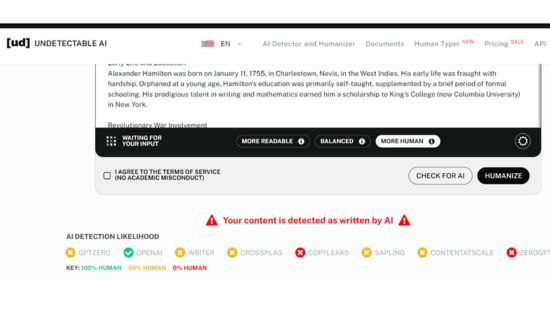
Simple Usage
Users enter artificial content into the tool’s easy interface. Automated undetectability algorithms evaluate linguistic patterns after pressing “Check for AI”.
Key Features
Undetectable.ai supports 10,000 characters per analysis with AI detection and content humanization. The current language models allow it to recognize text from GPT-3, GPT-4, Bard, Claude, and other popular generators.
Accuracy
Undetectable claims to be the most advanced and accurate AI detection tool, although it cannot guarantee accuracy. Initial third-party tests predict 85-95% detection.
Price
A limited freemium version allows small-scale exploration without text humanization. Personal plans for analyzing up to 10,000 words with customizable customization cost $5 per month.
Pros:
- Dual AI detection/humanization
- Up to 10,000 characters analyzed
- Experience that’s intuitive
- Finds latest AI models
Cons:
- Paid tiers may be unaffordable.
- Outdated interface graphics
2. Winston AI
Winston AI detects AI-generated material using machine learning in the cloud. Organizations can use it to detect AI-generated content in marketing, customer service, and other corporate communications.
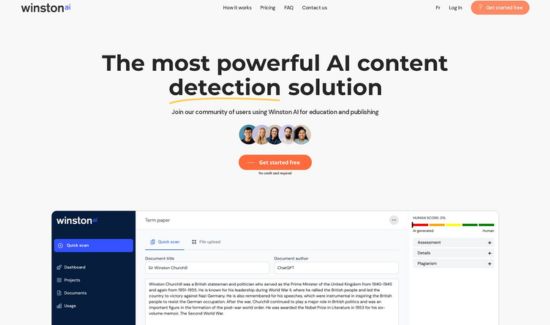
Simple Usage
Winston AI is simple to use. Users can upload a file or copy and paste text into Winston AI. After analyzing the text, the program will indicate whether it was created by AI. To verify text authenticity, the report offers useful information.
Key Features
The AI detector tool has many useful capabilities for content authenticity verification. Quick scan, file upload, OCR, project and document management, team management, language support, printable PDF reports, and plagiarism checker are among these features.
Accuracy
Winston AI claims it can recognize AI-generated text with 99.6% accuracy. It also analyzes text quickly. Scribbr reports 84% accuracy for the tool.
Price
Winston AI provides many price plans to meet user demands. Users who need minimal functionality should use the free basic plan. Paid programs offer advanced features. Monthly plans cost $18 and annual plans $12. The $49-per-month Elite package scans up to 500,000 words.
Pros:
- High precision.
- Detects all GPT-4 texts and most AI material.
- Features AI-generated text and capabilities to process handwritten papers.
- Comfortable AI detection interface
Cons:
- The service may be expensive for some users, and the free tier is limited to 2,000 words per month with a 500-word minimum session.
- Use requires registration.
3. Originality.AI
Originality.AI stands out as a cloud-based Artificial Intelligence Detectors and plagiarism checking solution. It accurately detects ChatGPT and Bard text using powerful machine learning. Also, it scans for copied content. This two-in-one approach effectively checks authenticity.
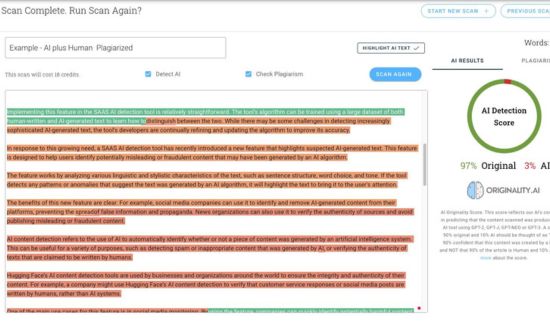
Simple Usage
Sign up and upload or enter the text to examine with Originality.AI. After uploading, click “Detect” to start AI detection. Check the detailed results for AI-generated content after detection.
Key Features
Originality.AI generates extensive reports that can be shared as needed, offering flexible analysis choices. Its Chrome extension, direct website scanning, file uploads for documents/PDFs, and multilingual capabilities provide text checking. The tool maximizes utility by supporting broad content compatibility and collaborative report sharing.
Accuracy
Originality.AI markets itself as an accurate AI detector. It detects AI-generated text over 95% accurately. The tool analyzes text rapidly and efficiently.
Price
Originality.AI offers free and paid plans for basic customers. Originality.AI’s pay-as-you-go 3000 credits cost $30. Each credit scans 100 words. Start at $14.95 a month for 2000 credits, with additional credits costing 1¢ each. End-of-month credits expire.
Pros:
- AI plagiarism detection 2-in-1
- Personalize thorough report sharing
- Team workflow features like multi-user access
- Score readability for optimization.
Cons:
- Limited pay-per-use capabilities
- User worries about detection accuracy/reliability
4. GLTR
Open-source Artificial Intelligence Detectors Giant Language Model Test Room (GLTR) can detect AI-generated content. The tool examines words using GPT-2 to determine AI prediction likelihood. It achieves it by focusing on the context before the word and calculating the likelihood that AI would construct a given sequence of words.
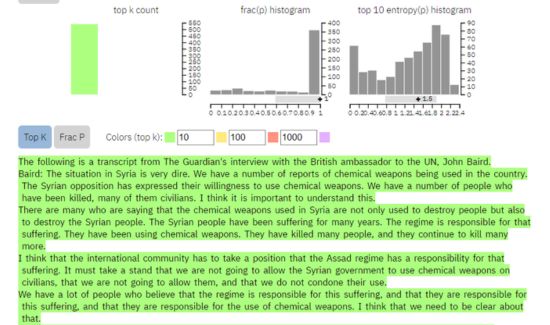
Simple Usage
Enter text into the box and GLTR will color words green if they are in the top 10 AI predictions. Yellow will appear for the top 100 predictions and red for the top 1,000. Everything over 1,000 is violet.
Key Features
GLTR uses forensic text analysis and AI generative probability to highlight problematic phrases. Users can study automatic content distribution trends using detailed histograms. These linguistic insights aim to accurately identify computer-generated language in phony reviews, comments, and news.
Accuracy
For free AI detector tools, GLTR is a decent choice. It is less accurate than some of the other tools on this list. Harvard researchers found that GLTR could detect AI-generated text with over 72% accuracy.
Price
GLTR is free.
Pros:
- Deep linguistic analysis for insights
- Color-coded highlights aids understanding
- Sees AI indicator in word placement
Cons:
- Developed in 2019, may not identify fresh AI material.
- New users struggle with complex results.
5. GPTZero
Open-source Artificial Intelligence Detectors GPTZero can detect AI-generated text. GPTZero uses a multi-step process to make accurate predictions with few false positives. It specializes in Chat GPT, GPT 3, GPT 4, Bard, and LLaMa content detection.
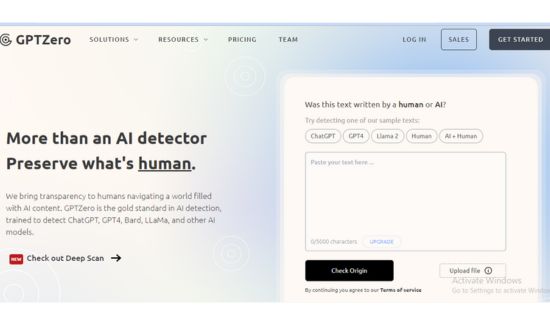
Simple Usage
Paste text or upload document to scan without signup. Analysis is nearly instant without accounts or emails. Copying any text snippet to validate yields results in under a minute.
Key features
GPTZero offers a dashboard with detailed analysis, graphic overviews, and granular statistics on AI likelihood per sentence. Researchers and users can utilize color coding and quantified linguistic analysis for high-level explainability and nuanced technical examination.
Accuracy
Scribbr found GPTZero less accurate than other AI detecting programs on this list. Binary judgments lower its accuracy score to 52%. Text is highlighted to label AI by the tool.
Price
The free plan scans 10,000 words each month at 7 checks per hour. The $10/month Essential plan scans 150,000 words. The $16/month Premium plan adds plagiarism checks, unlimited batches, and 300,000 words. Pricing accommodates individual and enterprise use cases.
Pros:
- Great dashboard view
- Has unique linguistic statistics
- Draws attention to text
- No signup, paste text
Cons:
- Low precision.
- Has no percentages
- Yes/no verdicts only
- A few false positives
Conclusion
In conclusion, the top 5 Artificial Intelligence Detectors strengthen AI security. Original, Winston AI, undetectable.AI, GLTR, and GPTZero protect against developing threats with various capabilities and precision. These detectors help ensure ethical use, mitigate hazards, and promote transparency as AI integration expands. Their role goes beyond protection to ensure secure, fair, and responsible AI incorporation into our technological world. As organizations and individuals adopt AI, these detectors help build trust and responsible AI development and implementation.
